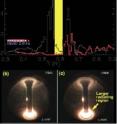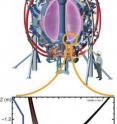Taming thermonuclear plasma with a snowflake
Related images
(click to enlarge)
Physicists working on the National Spherical Torus Experiment (NSTX) at the Princeton Plasma Physics Laboratory are now one step closer to solving one of the grand challenges of magnetic fusion research—how to reduce the effect that the hot plasma has on fusion machine walls (or how to tame the plasma-material interface). Some heat from the hot plasma core of a fusion energy device escapes the plasma and can interact with reactor vessel walls. This not only erodes the walls and other components, but also contaminates the plasma—all challenges for practical fusion. One method to protect machine walls involves divertors, chambers outside the plasma into which the plasma heat exhaust (and impurities) flow. A new divertor concept, called the "snowflake," has been shown to significantly reduce the interaction between hot plasma and the cold walls surrounding it. Strong magnetic fields shape the hot plasma in the form of a donut in a magnetic fusion plasma reactor called a tokamak. As confined plasma particles move along magnetic field lines inside the tokamak, some particles and heat escape because of instabilities in the plasma. Surrounding the hot plasma is a colder plasma layer, the scrape-off layer, which forms the plasma-material interface. In this layer, escaped particles and heat flow along an "open" magnetic field line to a separate part of the vessel and enter a "divertor chamber." If the plasma striking the divertor surface is too hot, melting of the plasma-facing components and loss of coolant can occur. Under such undesirable conditions, the plasma-facing component lifetime would also be an issue, as they would tend to wear off too quickly.
While the conventional magnetic X-point divertor concept has existed for three decades, a very recent theoretical idea and supporting calculations by Dr. D.D. Ryutov from Lawrence Livermore National Laboratory have indicated that a novel magnetic divertor—the "snowflake divertor"—would have much improved heat handling characteristics for the plasma-material interface. The name is derived from the appearance of magnetic field lines forming this novel magnetic interface.
This magnetic configuration was recently realized in NSTX and fully confirmed the theoretical predictions. The snowflake divertor configuration was created by using only two or three existing magnetic coils. This achievement is an important result for future tokamak reactors that will operate with few magnetic coils. Because the snowflake divertor configuration flares the scrape-off layer at the divertor surface, the peak heat load is considerably reduced, as was confirmed by the divertor heat flux on NSTX. The plasma in the snowflake divertor, instead of heating the divertor surface on impact, radiated the heat away, cooled down and did not erode the plasma-facing components as much, thus extending their lifetime. Plasma TV images show more divertor radiation in the snowflake divertor plasmas in comparison with the standard plasmas. Importantly, the snowflake divertor did not have an impact on the high performance and confinement of the high-temperature core plasma, and even reduced the impurity contamination level of the main plasma.
These highly encouraging results provide further support for the snowflake divertor as a viable plasma-material interface for future tokamak devices and for fusion development applications.
Source: American Physical Society
Articles on the same topic
- Fusion makes major step forward at MIT through studies of the plasma edgeMon, 8 Nov 2010, 11:30:44 UTC
- Getting to know the sun advances fusion researchMon, 8 Nov 2010, 11:30:42 UTC
- Imaging of Alfvén waves and fast ions in a fusion plasmaMon, 8 Nov 2010, 11:30:41 UTC
Other sources
- Major fusion advance: Breakthrough could help reduce heating of plasma container wallsfrom Science DailyMon, 8 Nov 2010, 20:30:48 UTC
- Fusion makes major step forward at MIT through studies of the plasma edgefrom PhysorgMon, 8 Nov 2010, 14:00:29 UTC
- Imaging of Alfvén waves and fast ions in a fusion plasmafrom Science DailyMon, 8 Nov 2010, 13:30:57 UTC
- Taming thermonuclear plasma with a snowflakefrom Science DailyMon, 8 Nov 2010, 13:30:52 UTC
- Imaging of Alfven waves and fast ions in a fusion plasmafrom PhysorgMon, 8 Nov 2010, 13:00:47 UTC
- Fusion makes major step forward at MIT through studies of the plasma edgefrom Science BlogMon, 8 Nov 2010, 12:10:23 UTC
- Taming thermonuclear plasma with a snowflakefrom Science BlogMon, 8 Nov 2010, 11:40:22 UTC
- Imaging of Alfvén waves and fast ions in a fusion plasmafrom Science BlogMon, 8 Nov 2010, 11:40:17 UTC
- Taming thermonuclear plasma with a snowflakefrom PhysorgMon, 8 Nov 2010, 11:10:21 UTC

